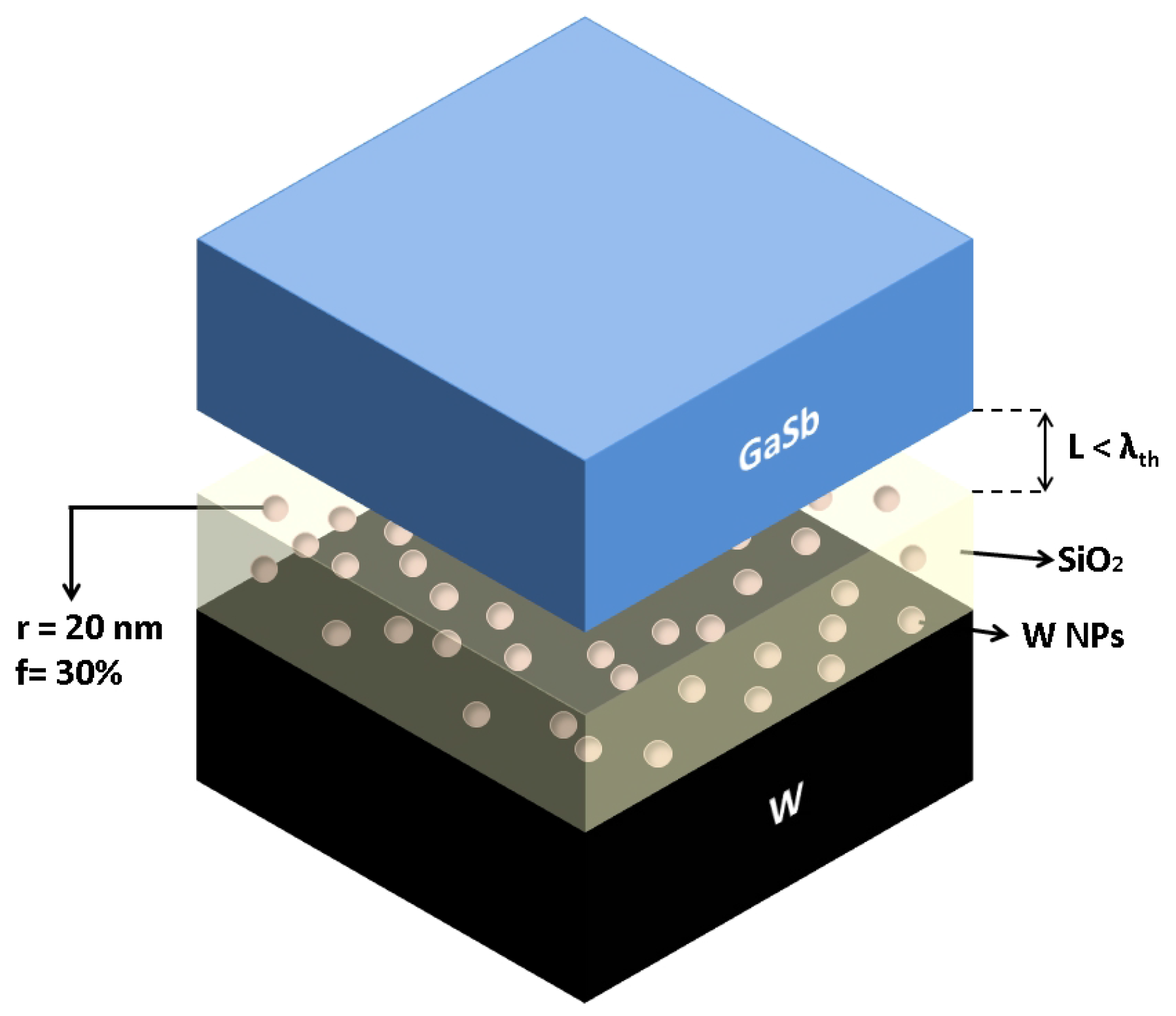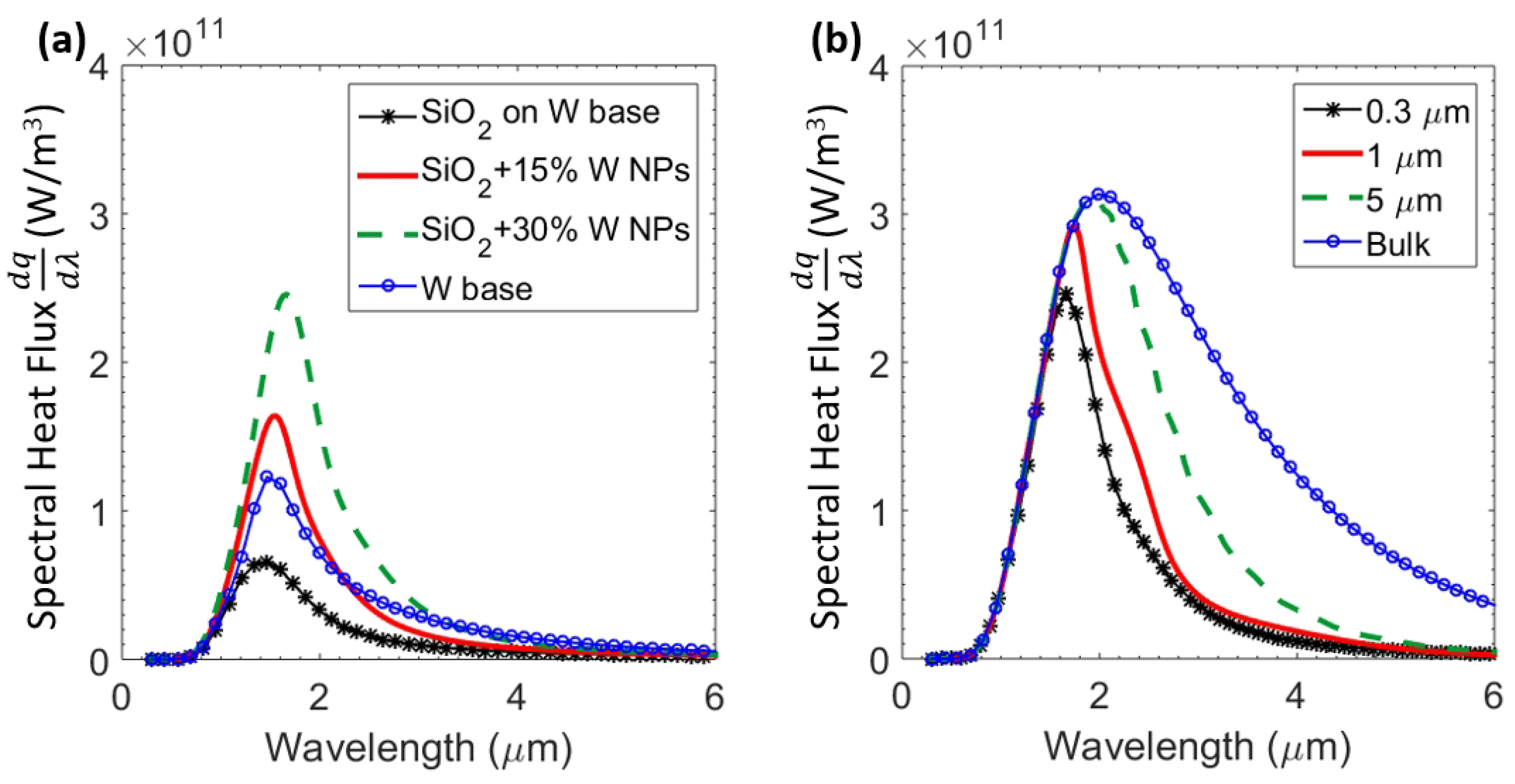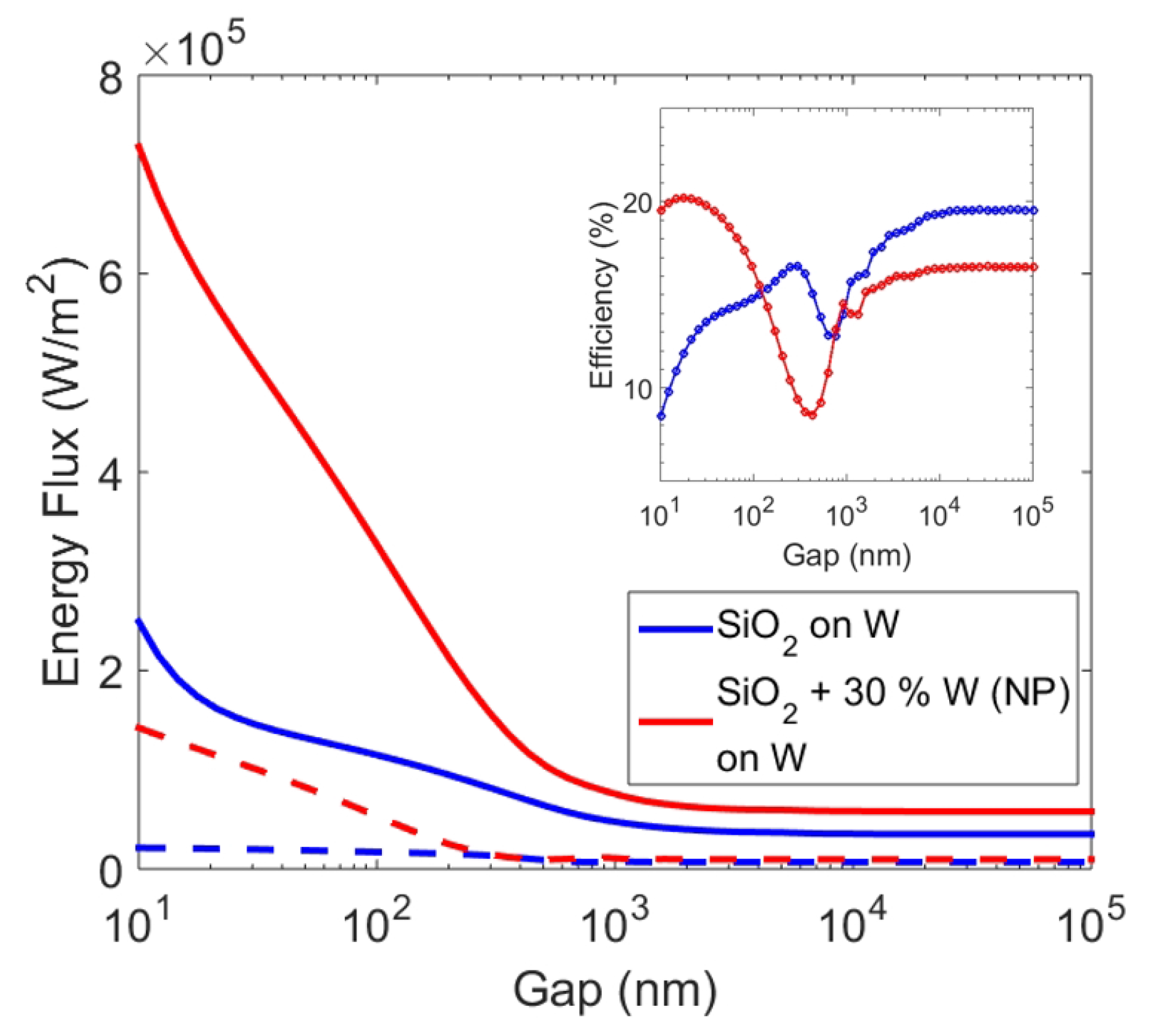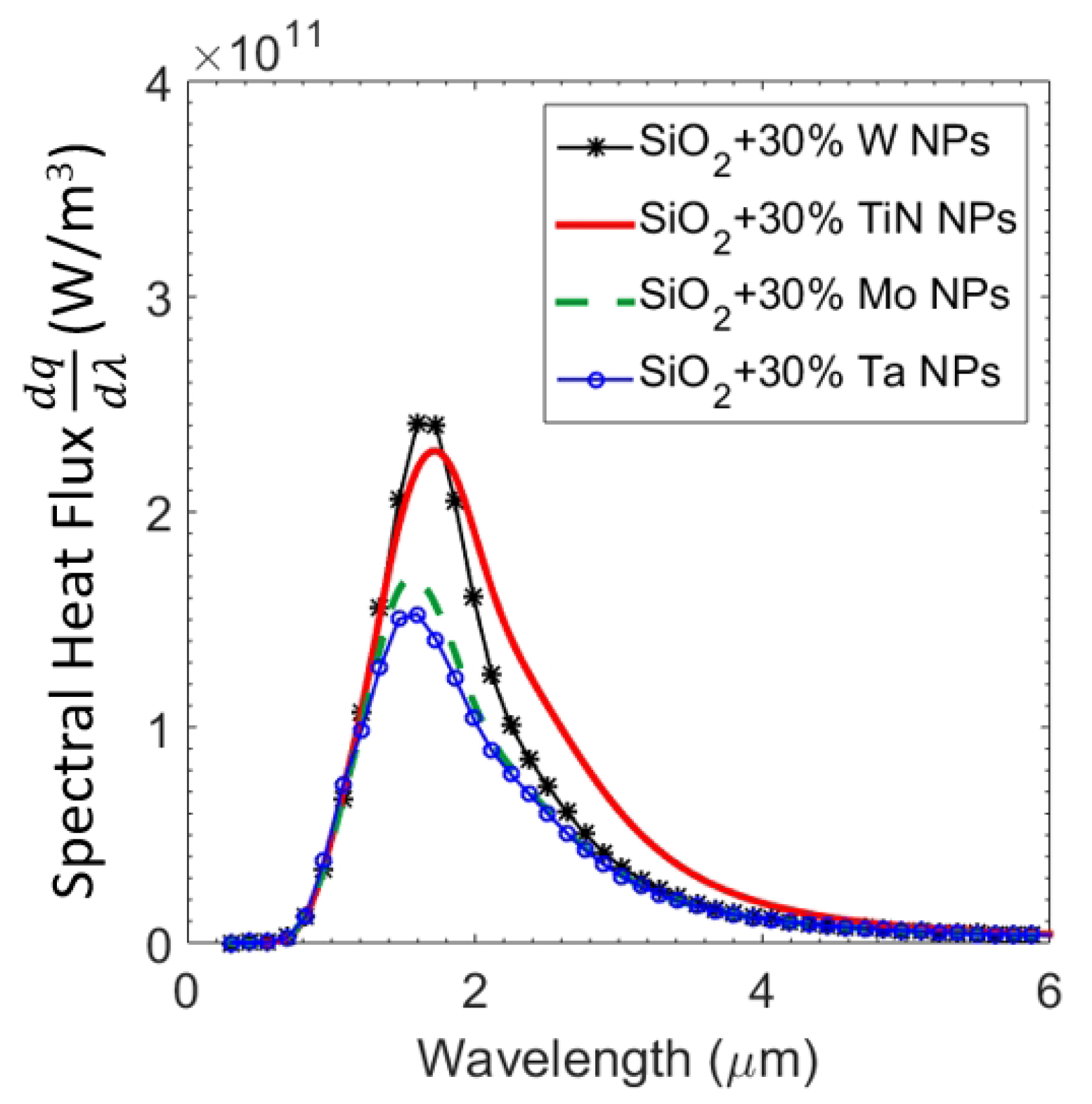Mie-Metamaterials-Based Thermal Emitter for Near-Field Thermophotovoltaic Systems
Abstract
:1. Introduction
2. Results and Discussion
3. Materials and Methods
Acknowledgments
Author Contributions
Conflicts of Interest
References
- Basu, S.; Chen, Y.; Zhang, Z. Microscale radiation in thermophotovoltaic devices-a review. Int. J. Energy Res. 2007, 31, 689–716. [Google Scholar] [CrossRef]
- Bosi, M.; Ferrari, C.; Melino, F.; Pinelli, M.; Spina, P.; Venturini, M. Thermophotovoltaic generation: A state of the art review. In Proceedings of the 25th International Conference on Efficiency, Cost, Optimization and Simulation of Energy Conversion Systems and Processes, Perugia, Italy, 26–29 June 2012. [Google Scholar]
- Coutts, T. A review of progress in thermophotovoltaic generation of electricity. Renew. Sustain. Energy Rev. 1999, 3, 77–184. [Google Scholar] [CrossRef]
- Tong, J.K.; Hsu, W.C.; Huang, Y.; Boriskina, S.V.; Chen, G. Thin-film ‘thermal well’emitters and absorbers for high-efficiency thermophotovoltaics. Sci. Rep. 2015, 5, 10661. [Google Scholar] [CrossRef] [PubMed]
- Harder, N.P.; Würfel, P. Theoretical limits of thermophotovoltaic solar energy conversion. Semicond. Sci. Technol. 2003, 18, S151. [Google Scholar] [CrossRef]
- Rephaeli, E.; Fan, S. Absorber and emitter for solar thermo-photovoltaic systems to achieve efficiency exceeding the Shockley-Queisser limit. Opt. Express 2009, 17, 15145–15159. [Google Scholar] [CrossRef] [PubMed]
- Wurfel, P.; Ruppel, W. Upper limit of thermophotovoltaic solar-energy conversion. IEEE Trans. Electron Devices 1980, 27, 745–750. [Google Scholar] [CrossRef]
- Bermel, P.; Ghebrebrhan, M.; Chan, W.; Yeng, Y.X.; Araghchini, M.; Hamam, R.; Marton, C.H.; Jensen, K.F.; Soljačić, M.; Joannopoulos, J.D.; et al. Design and global optimization of high-efficiency thermophotovoltaic systems. Opt. Express 2010, 18, A314–A334. [Google Scholar] [CrossRef] [PubMed]
- Liu, X.; Tyler, T.; Starr, T.; Starr, A.F.; Jokerst, N.M.; Padilla, W.J. Taming the blackbody with infrared metamaterials as selective thermal emitters. Phys. Rev. Lett. 2011, 107, 045901. [Google Scholar] [CrossRef] [PubMed]
- Wu, C.; Neuner, B., III; John, J.; Milder, A.; Zollars, B.; Savoy, S.; Shvets, G. Metamaterial-based integrated plasmonic absorber/emitter for solar thermo-photovoltaic systems. J. Opt. 2012, 14, 024005. [Google Scholar] [CrossRef]
- Molesky, S.; Dewalt, C.J.; Jacob, Z. High temperature epsilon-near-zero and epsilon-near-pole metamaterial emitters for thermophotovoltaics. Opt. Express 2013, 21, A96–A110. [Google Scholar] [CrossRef] [PubMed]
- Nagpal, P.; Han, S.E.; Stein, A.; Norris, D.J. Efficient low-temperature thermophotovoltaic emitters from metallic photonic crystals. Nano Lett. 2008, 8, 3238–3243. [Google Scholar] [CrossRef] [PubMed]
- Arpin, K.A.; Losego, M.D.; Cloud, A.N.; Ning, H.; Mallek, J.; Sergeant, N.P.; Zhu, L.; Yu, Z.; Kalanyan, B.; Parsons, G.N.; et al. Three-dimensional self-assembled photonic crystals with high temperature stability for thermal emission modification. Nat. Commun. 2013, 4. [Google Scholar] [CrossRef] [PubMed]
- Heinzel, A.; Boerner, V.; Gombert, A.; Bläsi, B.; Wittwer, V.; Luther, J. Radiation filters and emitters for the NIR based on periodically structured metal surfaces. J. Mod. Opt. 2000, 47, 2399–2419. [Google Scholar] [CrossRef]
- Fleming, J.; Lin, S.; El-Kady, I.; Biswas, R.; Ho, K. All-metallic three-dimensional photonic crystals with a large infrared bandgap. Nature 2002, 417, 52–55. [Google Scholar] [CrossRef] [PubMed]
- Sai, H.; Kanamori, Y.; Yugami, H. Tuning of the thermal radiation spectrum in the near-infrared region by metallic surface microstructures. J. Micromech. Microeng. 2005, 15, S243. [Google Scholar] [CrossRef]
- Ghanekar, A.; Sun, M.; Zhang, Z.; Zheng, Y. Optimal Design of Wavelength Selective Thermal Emitter for Thermophotovoltaic Applications. J. Therm. Sci. Eng. Appl. 2007, 10, 011004. [Google Scholar]
- Woolf, D.; Hensley, J.; Cederberg, J.; Bethke, D.; Grine, A.; Shaner, E. Heterogeneous metasurface for high temperature selective emission. Appl. Phys. Lett. 2014, 105, 081110. [Google Scholar] [CrossRef]
- Narayanaswamy, A.; Chen, G. Surface modes for near field thermophotovoltaics. Appl. Phys. Lett. 2003, 82, 3544–3546. [Google Scholar] [CrossRef]
- DiMatteo, R.; Greiff, P.; Seltzer, D.; Meulenberg, D.; Brown, E.; Carlen, E.; Kaiser, K.; Finberg, S.; Nguyen, H.; Azarkevich, J.; et al. Micron-gap T hermo P hoto V oltaics (MTPV). AIP Conf. Proc. 2004, 738, 42–51. [Google Scholar]
- Laroche, M.; Carminati, R.; Greffet, J.J. Near-field thermophotovoltaic energy conversion. J. Appl. Phys. 2006, 100, 063704. [Google Scholar] [CrossRef]
- Park, K.; Basu, S.; King, W.P.; Zhang, Z. Performance analysis of near-field thermophotovoltaic devices considering absorption distribution. J. Quant. Spectrosc. Radiat. Transf. 2008, 109, 305–316. [Google Scholar] [CrossRef]
- Francoeur, M.; Vaillon, R.; Mengüç, M.P. Thermal impacts on the performance of nanoscale-gap thermophotovoltaic power generators. IEEE Trans. Energy Convers. 2011, 26, 686–698. [Google Scholar] [CrossRef]
- Bright, T.; Wang, L.; Zhang, Z. Performance of near-field thermophotovoltaic cells enhanced with a backside reflector. J. Heat Transf. 2014, 136, 062701. [Google Scholar] [CrossRef]
- Ghanekar, A.; Lin, L.; Su, J.; Sun, H.; Zheng, Y. Role of nanoparticles in wavelength selectivity of multilayered structures in the far-field and near-field regimes. Opt. Express 2015, 23, A1129–A1139. [Google Scholar] [CrossRef] [PubMed]
- Ghanekar, A.; Lin, L.; Zheng, Y. Novel and efficient Mie-metamaterial thermal emitter for thermophotovoltaic systems. Opt. Express 2016, 24, A868–A877. [Google Scholar] [CrossRef] [PubMed]
- Francoeur, M.; Basu, S.; Petersen, S.J. Electric and magnetic surface polariton mediated near-field radiative heat transfer between metamaterials made of silicon carbide particles. Opt. Express 2011, 19, 18774–18788. [Google Scholar] [CrossRef] [PubMed]
- Zhao, Q.; Zhou, J.; Zhang, F.; Lippens, D. Mie resonance-based dielectric metamaterials. Mater. Today 2009, 12, 60–69. [Google Scholar] [CrossRef]
- Wheeler, M.S.; Aitchison, J.S.; Mojahedi, M. Three-dimensional array of dielectric spheres with an isotropic negative permeability at infrared frequencies. Phys. Rev. B 2005, 72, 193103. [Google Scholar] [CrossRef]
- Adachi, S. Optical dispersion relations for GaP, GaAs, GaSb, InP, InAs, InSb, AlxGa1-xAs, and In1-xGaxAsyP1-y. J. Appl. Phys. 1989, 66, 6030–6040. [Google Scholar] [CrossRef]
- Ji, T.; Peng, L.; Zhu, Y.; Yang, F.; Cui, Y.; Wu, X.; Liu, L.; He, S.; Zhu, F.; Hao, Y. Plasmonic broadband absorber by stacking multiple metallic nanoparticle layers. Appl. Phys. Lett. 2015, 106, 161107. [Google Scholar] [CrossRef]
- Sakurai, A.; Kawamata, T. Electromagnetic resonances of solar-selective absorbers with nanoparticle arrays embedded in a dielectric layer. J. Quant. Spectrosc. Radiat. Transf. 2016, 184, 353–359. [Google Scholar] [CrossRef]
- Reed, J.S. Principles of Ceramics Processing; Wiley: Hoboken, NJ, USA, 1995. [Google Scholar]
- Sahoo, P.K.; Kamal, S.K.; Premkumar, M.; Kumar, T.J.; Sreedhar, B.; Singh, A.; Srivastava, S.; Sekhar, K.C. Synthesis of tungsten nanoparticles by solvothermal decomposition of tungsten hexacarbonyl. Int. J. Refract. Met. Hard Mater. 2009, 27, 784–791. [Google Scholar] [CrossRef]
- Rodriguez-Suarez, T.; Diaz, L.; Lopez-Esteban, S.; Pecharroman, C.; Esteban-Cubillo, A.; Gremillard, L.; Torrecillas, R.; Moya, J. Epitaxial growth of tungsten nanoparticles on alumina and spinel surfaces. Nanotechnology 2008, 19, 215605. [Google Scholar] [CrossRef] [PubMed]
- Narayanaswamy, A.; Zheng, Y. A Green’s function formalism of energy and momentum transfer in fluctuational electrodynamics. J. Quant. Spectrosc. Radiat. Transf. 2014, 132, 12–21. [Google Scholar] [CrossRef]
- Chew, W.C. Waves and Fields in Inhomogeneous Media; IEEE Press: New York, NY, USA, 1995. [Google Scholar]
- Myroshnychenko, V.; Rodríguez-Fernández, J.; Pastoriza-Santos, I.; Funston, A.M.; Novo, C.; Mulvaney, P.; Liz-Marzán, L.M.; de Abajo, F.J.G. Modelling the optical response of gold nanoparticles. Chem. Soc. Rev. 2008, 37, 1792–1805. [Google Scholar] [CrossRef] [PubMed]
- Kreibig, U.; Vollmer, M. Optical Properties of Metal Clusters; Springer: Berlin, Germany, 1995; Volume 25. [Google Scholar]
- Doyle, W.T. Optical properties of a suspension of metal spheres. Phys. Rev. B 1989, 39, 9852. [Google Scholar] [CrossRef]
- Wheeler, M.S. A Scattering-Based Approach to the Design, Analysis, and Experimental Verification of Magnetic Metamaterials Made from Dielectrics. Ph.D. Thesis, University of Toronto, Toronto, ON, Canada, 2010. [Google Scholar]
- Gao, L.; Lemarchand, F.; Lequime, M. Refractive index determination of SiO2 layer in the UV/Vis/NIR range: Spectrophotometric reverse engineering on single and bi-layer designs. J. Eur. Opt. Soc.-Rapid Publ. 2013, 8, 13010. [Google Scholar] [CrossRef]
- Rakić, A.D.; Djurišić, A.B.; Elazar, J.M.; Majewski, M.L. Optical properties of metallic films for vertical-cavity optoelectronic devices. Appl. Opt. 1998, 37, 5271–5283. [Google Scholar] [CrossRef] [PubMed]
- Timans, P. Advances in Rapid Thermal and Integrated Processing; Roozeboom, F., Ed.; Kluwer Academic Publishers: Dordrecht, The Netherlands, 1996. [Google Scholar]
- McKelvey, J.P. Solid State and Semiconductor Physics; Harper & Row: Manhattan, NY, USA, 1966. [Google Scholar]






© 2017 by the authors. Licensee MDPI, Basel, Switzerland. This article is an open access article distributed under the terms and conditions of the Creative Commons Attribution (CC BY) license (http://creativecommons.org/licenses/by/4.0/).
Share and Cite
Ghanekar, A.; Tian, Y.; Zhang, S.; Cui, Y.; Zheng, Y. Mie-Metamaterials-Based Thermal Emitter for Near-Field Thermophotovoltaic Systems. Materials 2017, 10, 885. https://doi.org/10.3390/ma10080885
Ghanekar A, Tian Y, Zhang S, Cui Y, Zheng Y. Mie-Metamaterials-Based Thermal Emitter for Near-Field Thermophotovoltaic Systems. Materials. 2017; 10(8):885. https://doi.org/10.3390/ma10080885
Chicago/Turabian StyleGhanekar, Alok, Yanpei Tian, Sinong Zhang, Yali Cui, and Yi Zheng. 2017. "Mie-Metamaterials-Based Thermal Emitter for Near-Field Thermophotovoltaic Systems" Materials 10, no. 8: 885. https://doi.org/10.3390/ma10080885



